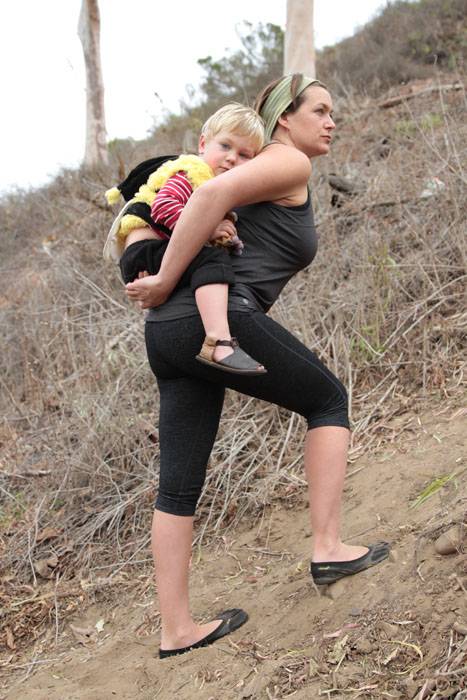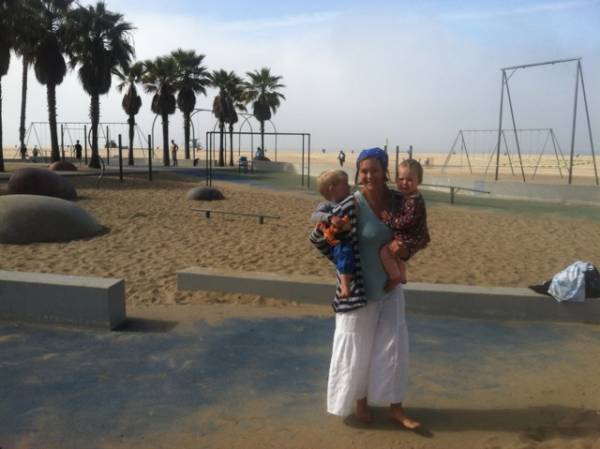I used think babies have four basic needs. They need to eat, sleep, and relieve themselves. They also need human companionship and love. But that list overlooks one of the biggest things babies need and desperately want: freedom of movement.
Our culture has a tendency to restrain babies. We swaddle them, put them in strollers, and tie them up in baby carriers. Now don’t get me wrong – there’s nothing wrong with any of these things. But how often do you see people walking through the grocery store carrying their baby, sans carrier or stroller? Does that cultural tendency have any effect on infant development – not to mention parental development?
In Katy Bowman’s newest presentation, Paleo Parenting, she describes the baby’s need for movement. “We tend to see a crying baby as tired, not fed, in pain, or uncomfortable. The modern gatherer’s first response to a crying baby is that the child is undermoved. That’s their first go-to.” This is where baby transportation comes in. Moving your baby from point A to point B is not only about getting them (or you) to a destination. It is a naturally-occurring opportunity for a baby to get what Katy calls “mechanical nutrients.” From a biomechanical perspective, carrying your baby – and by that I mean plain and simple holding of the child with no additional gadgets – places a unique load on baby’s developing musculature that you just can’t get with other modes of transportation. It teaches your baby to hold his or her head upright without support from an early age, and gets you both out of what Katy calls a position rut:
We’re stuck in a position rut, because we can’t imagine asking our kids to sit up vertically while nursing, or training our kids to hold on when they’re just a few months old. These limitations in our body positions are due to our limited way of thinking, brought upon us by our cultural experience. And when we limit our geometry, we in turn pass those limitations on to our children. They become strong in a single position or breastfeeding latch and then prefer to use it, thus reinforcing that pattern. Variance of position is the key to robust development, but we have to think out of our cultural box that approaches human development from an ergonomic perspective and sets the dial of human experience to static.
So, are we bad parents if we use baby carriers instead of toting our kids around in our arms? This question is symptomatic of a deeper cultural paradigm, what Katy called the ergonomic perspective. This approach looks for the single best position to use for a given task. The problem is, as Katy noted, “There is no single position that optimizes human development. Rather, what optimizes human development is the ability to move constantly to avoid adaptation to a single position…If there is anything a broader look at research into disease shows us, it is that ‘single position’ is the problem.” The specific methods of baby transportation are not the issue. The issue is that as parents and caregivers, we are building a movement matrix, and that matrix should be as varied as possible.
Of course, since holding your baby is more demanding, proper alignment is key for pain-free carrying. As Katy said, “Working on your personal alignment will help you use more appropriate muscles to do the holding. If you’re prone to neck and shoulder tension, you’ll carry these patterns with you when you go to baby-hold.” If your own alignment needs work, Katy’s “alignment snacks” videos provide correctives to help you get on the right track.

Strollers, Moby wraps, and Mei Tais are not the problem or the solution. And neither is carrying your baby everywhere all the time – that’s impossible. The answer is varied movement that trains the specific movements you want to accomplish without pain. “The adaption of your physiology follows the Law of Specificity, which says if you want to be better equipped for something (like carrying your kids), you have to use your body in a similar way beforehand.”
To illustrate, Katy told me a story about what happens when a biomechanist parent encounters a bodybuilder parent at an amusement park:
True story: My husband and I were at an amusement park and there was this super buff bodybuilding guy there pushing his two girls in a stroller. My husband and I had been carrying our one and two year old for over an hour, while walking a couple of miles, and he came over and said “How can you carry them that long? That would totally kill my back!” He was way ‘stronger’ and stronger-looking than either of us, but his strength was in a particular way.
For us, being able to carry our kids is a natural and functional strength that we train for hours a day. Sixty minutes three or four times a week (read: exercise), selecting modes and moves that are designed to improve generic health variables is not specific or frequent enough to keep up with the loads created by carrying squirming, live animals with opinions…Carry them as much as possible, while they’re smaller and lighter. Carry them a couple hours a day while they’re growing. This keeps you in the necessary shape. Law of specificity, baby. Learn it.

This story brings me to one of the most common reasons I hear parents give for not carrying their kids around: it’s uncomfortable, or even worse, it hurts. One of our knee-jerk reactions to pain is to stop doing the movement we correlate with pain or discomfort. A lesson I’ve learned as a doula is that we need to alter this attitude about pain and discomfort and take both as a cue to change position frequently. This applies to a woman in labor, and it also applies to a parent carrying a baby. As Katy noted:
The reason baby-holding positions (or breastfeeding ones for that matter) become painful is that they’re supposed to. Nothing encourages ‘change your position’ like a signal saying that, right now, you’ve exceeded your strength for doing it this way. In the same way there is not one best way to sit or stand all day long, there’s no best way to carry or nurse your baby. Arms are tired? Switch sides. Try holding a different way.
If you’ve made it this far and you’re one of those parents who experiences pain after carrying your baby or toddler, you’re probably wondering what you can do. Here’s a helpful video to teach us all something about pain-free baby holding:
To sum it all up: carry your baby when you can. When you carry him or her, listen to your body’s cues. And speaking of cues, if your baby has been crying inconsolably and food, swaddling, and a diaper change haven’t helped, try going for a walk outside. Movement, like food, is nutrition, and babies need it.
For more information, Katy Bowman’s presentation “Paleo Parenting: A Biomechanical Perspective” is an excellent expansion on this topic.
Read more Katy interviews:
Katy Bowman and the Biomechanics of Human Growth: The Necessity of Monkey Business
Katy Bowman and the Biomechanics of Human Growth: Barefoot Babies






